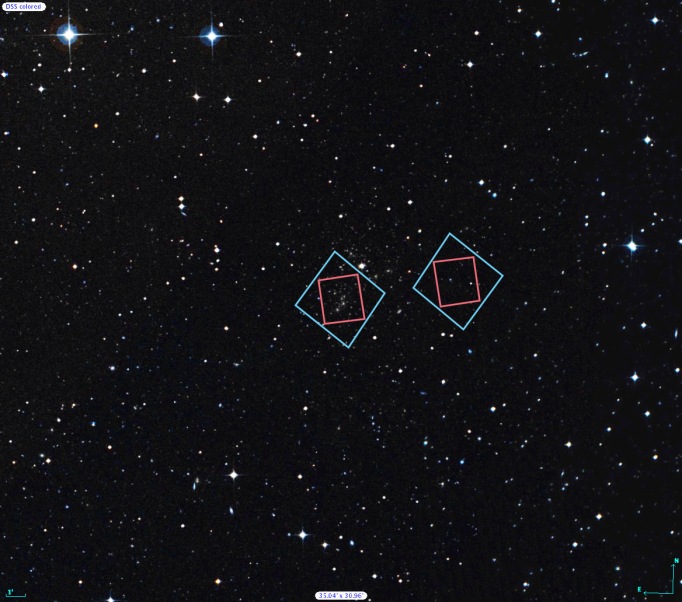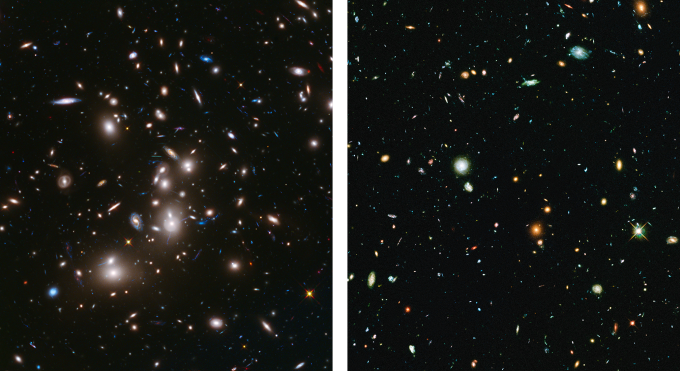Abell 2744, also known as Pandora’s Cluster, is a giant pile-up of four smaller galaxy clusters. Abell 2744, and its neighboring parallel field, are among the first targets of the Frontier Fields program.
The Abell catalogue of galaxy clusters was first compiled by astronomer George O. Abell in 1958, with over 2,700 galaxy clusters observable from the Northern Hemisphere. The Abell catalogue was updated in 1989 with galaxy clusters from the Southern Hemisphere.

The locations of Hubble’s observations of the Abell 2744 galaxy cluster (left) and the adjacent parallel field (right) are plotted over a Digitized Sky Survey (DSS) image. The blue boxes outline the regions of Hubble’s visible-light-observations, and the red boxes indicate areas of Hubble’s infrared-light observations. A scale bar in the lower left corner of the image indicates the size of the image on the sky. The scale bar corresponds to approximately 1/30th the apparent width of the full moon as seen from Earth. Astronomers refer to this unit of measurement as one arcminute, denoted as 1′.
Credit: Digitized Sky Survey (STScI/NASA) and Z. Levay (STScI).

Shown here, with approximately half of the expected data included, are the early Frontier Fields images of Abell 2744 and the associated parallel field. Left: Frontier Fields image of the galaxy cluster Abell 2744 is displayed with colors chosen to highlight the newly obtained infrared data. The infrared-light-data are shown in red. Visible light data are included from archived observations and displayed in blue and green. Right: The new Frontier Fields image of the adjacent parallel field is displayed. In this image, all of the colors represent visible-light data.
Credit: NASA, ESA, and J. Lotz, M. Mountain, A. Koekemoer, and the HFF Team (STScI)
To see the final completed Frontier Fields images of Abell 2744 and parallel field, go here.
Estimated Dates of Observations: October-November 2013 and May-June 2014
The planned dates for Hubble observations of the Frontier Fields include observations approximately six months apart. This is the time it takes for the cameras on Hubble to swap positions so that both visible-light data and infrared-light data can be captured from the galaxy cluster field and the adjacent parallel field, as described in this post.
Galaxy Cluster Cosmological Redshift: 0.308
Redshift measures the lengthening of a light wave from an object that is moving away from an observer. For example, when a galaxy is traveling away from Earth, its observed wavelength shifts toward the red end of the electromagnetic spectrum. The galaxy cluster’s cosmological redshift refers to a lengthening of a light wave caused by the expansion of the universe. Light waves emitted by a galaxy cluster stretch as they travel through the expanding universe. The greater the redshift, the farther the light has traveled to reach us.
Galaxy Cluster Distance: approximately 3.5 billion light-years
Galaxy Cluster Field Coordinates (R.A., Dec.): 00:14:21.2, -30:23:50.1
Parallel Field Coordinates (R.A., Dec.): 00:13:53.6, -30:22:54.3
Constellation: Sculptor
Related Hubble News:
- Hubble and Spitzer Space Telescopes Find One of the Youngest Galaxies in the Universe
- Frontier Fields: Hubble Goes Deep (science content reading for students & educators)
- Hubble’s First Frontier Field Finds Thousands of Unseen, Faraway Galaxies
- NASA’s Great Observatories Begin Deepest Ever Probe of the Universe
- Pandora’s Cluster – Clash of the Titans
- Hubble Finds Extremely Distant Galaxy through Cosmic Magnifying Glass
- Hubble Sees Ghost Light from Dead Galaxies
Looking for Hubble data used by scientists?

I am Interest by deep space objects,Hubble makes visible!What is the “youngest” galaxy?
Hello. It is difficult to answer because the term “youngest” is complicated for several reasons. First, galaxies are constantly merging with other galaxies – the Milky Way has been merging with galaxies, mostly much much smaller in size – for billions of years. Galaxies do not live in isolation.
Second, as we look further in space we are seeing the galaxies as they existed back in the past – when they were younger. For the furthest galaxies we can detect, we have no idea what those particular galaxies look like in the present time, but they are, by definition, the youngest galaxies ever detected because we are seeing them as they existed in a time when all galaxies were younger than today. For example, assume two people were born at roughly the same time. You see the first as an adult and the second via a picture of them when they were a baby. The second person is younger, but only because you are seeing him/her as he/she existed years ago.
With that said, we are interested in finding the furthest/youngest galaxies because they can tell us much of how galaxies looked and behaved in the early universe and how they evolved with time to become the majestic spirals, massive ellipticals, and messy irregulars that we see today. Those galaxies with the largest redshift (z) value – which means they are the furthest away – will give us glimpses of the earliest galaxies. The universe is around 13.7 billion years old. We have evidence that we have detected a few galaxies as they appeared at approximately 500-750 million years after the Big Bang – or about 3+% of the present age of the universe. With the Frontier Fields, we aim to peer deeper for glimpses of even younger galaxies.
I know it’s been a few years, but this is such a great responce! Thanks for being so thorough!
Too many questions I have bout deep space! im unable to list them up!!
[…] Abell 2744 […]
[…] Abell 2744 […]
[…] Abell 2744 […]
[…] Abell 2744 […]
[…] Abell 2744 […]
[…] Abell 2744 […]
[…] Abell 2744 […]
[…] example of images taken by Hubble, Spitzer, and Chandra of the Frontier Fields galaxy cluster Abell 2744 are shown below. These images show how astronomers can use color to highlight the type of light […]